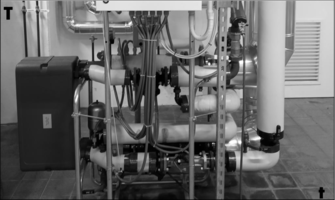Leave second generation behind: Cost-effective solutions for small to large scale DH networks

Downloads & Links
Register for free and log in in the upper right corner of the website to download the final report and a presentation.
Videos
Project summary
Currently several European district heating networks are of 2 generation type and operate with superheated water at >100°C and pressure over the environmental. To meet long-term decarbonization targets require rapid pathways to transform existing networks into low-temperature systems in a cost-effective manner. Low temperature networks allow to valorize industrial waste heat and renewable heat, to increase the efficiency of CHPs, and to reduce thermal losses.
Supply temperature reduction of 2nd generation DH is hampered by three main types of barriers: on the network, on the substation and on the heating devices. First, temperature reductions cause a diminished supply-return temperature difference, leading to potentially unsustainable increases of network flow rates so that heat demand is still met. The problem is exacerbated in large networks (~ 100 km or more), where supply flow rates are inherently large to begin with. A second problem concerns the capability of the substation to provide the required amount of heat to the heating system when it is supplied at lower temperature. The third problem is related to the limitation on the exchange area of the radiators installed in the indoor environment.
The overarching aim of the project is therefore to develop transformative cost-effective routes for the transition of existing networks into low-carbon energy systems through reduction of supply temperature. The main novelty of the project with respect to the existing research is to evaluate, with proper tools, to what extent these barriers can be
removed.
In this context, the project aims to propose/develop and test proper actions in order to face the issues related to the first and the second type of problems (network and substation side). The benefits of the proposed solutions will be tested through improved methods based on validated models already developed by the consortium. Tests will be performed considering existing medium-large networks that urgently need interventions to reduce supply temperature, like Turin (800 km, 2000 GWh/y) and Grenoble (170 km, 720 GWh/y).
In the project, the actions that will be considered to tackle limitations due to network and substation are: A1) intervention on specific fluid-dynamic bottlenecks (e.g. pipeline diameter change); A2) proper use of demand-side management; A3) recirculation of mass flow rates in crucial points of the network and use of heat pumps to increase locally the water temperature; A4) optimal operation of booster pumping station; A5) connection of buildings equipped with low temperature heating systems on the return network; A6) proper supply temperature setting; A7) optimal modification of the network topology through new pipeline inclusion; A8) proper installation of thermal storages (sensible and latent heat); A9) suitable control of thermal substations.
In case of specific need further options will be included in the analysis during the project execution.
The impact of the various actions on the existing representative networks will be assessed with the aid of numerical models, so that the expected effects in terms
of primary energy reduction, cost variations, impact on the end-users are quantified. A cost/benefit analysis will be performed for the various actions with
the aim of identifying the pros and cons of the approaches proposed and the best solutions for the transition.
Target audience and specific issues
- DH operators
- DH managers
- DH researchers
Deliverables / Outcomes
- The definition of the constraints limiting transition of 2nd generation district heating networks to lower supply temperature and proposal of possible solutions, taking into account the data barriers and the strategies to overcome them; in this context DH operators will be involved in this step, with the aim of including hands-on experience.
- A general methodological framework to support the assessment, design, replication and adoption of the actions to reduce temperature into networks beyond those investigated in the project (A1-A9);
- Cost-benefits quantification for the identified temperature reduction actions when applied to selected case-studies.
- A guideline (intended for target groups: DH operators/managers and researchers) based on the outcomes 1)-3), on the actions more suitable to overcome the issues related to the supply temperature reduction.
Project lead
Politecnico di Torino (Technical University)
Corso Duca degli abruzzi 24,
Turin,
Italy
Dr. Elisa Guelpa
Phone number: +39 011 090 44 78
Email: elisa.guelpa@polito.it
Partner Organizations
- CEA (Commissariat à l'énergie atomique et aux énergies alternatives), France
University of Birmingham, School of Chemical Engineering, UK


